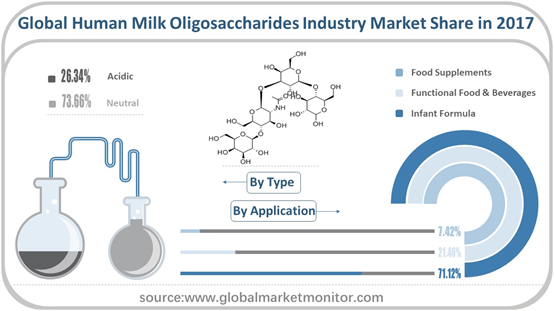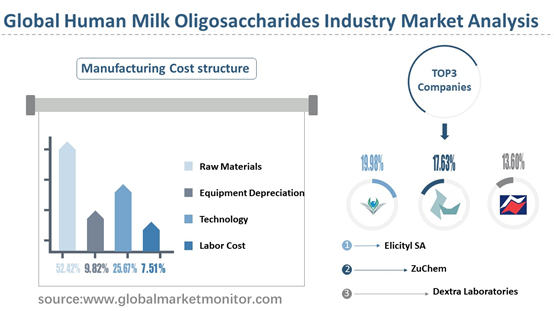Human
milk oligosaccharides are sugar molecules, part of the oligosaccharides group,
which can be found in high concentrations of 0.35-0.88 oz./L exclusively in
human breast milk. They form the third most abundant solid component of human milk
after lactose and fat. Human milk oligosaccharides (HMOs) are a family of
structurally diverse unconjugated glycan that are found in and unique to human
breast milk, despite not actually being digestible by human infants. HMOs not
only function as a prebiotic helping to establish commensal bacteria, but also
function as anti-adhesives that help prevent the attachment of microbial
pathogens to mucosal surfaces.
Human
milk oligosaccharides are produced by a variety of processes involving the use
of several chemicals, enzymes or microorganisms. At present, only some
companies have technology to mass produce, and technological innovation and
progress are still immature. However, as the demand for functional beverages
and the demand for infant formula have increased, the industry has been
promoted. In 2018, infant formulas in Europe approved to include a human milk
oligosaccharide ingredient that helps close gap between human breast milk and formula,
which will promote the use of human milk oligosaccharides in infant formula.
Human
milk oligosaccharides can be divided into acidic and neutral according to their
types. Acidic human milk oligosaccharide is an oligosaccharide comprising a
structure of sialic acid and a sulfate thereof, while neutral human milk
oligosaccharide is an oligosaccharide containing fructosyl.

Human milk oligosaccharides can be used as food supplements. A food supplement is defined in EU law as any food the purpose of which is to supplement the normal diet and which is a concentrated source of a vitamin or mineral or other substance with a nutritional or physiological effect, alone or in combination and is sold in dose form. Human milk oligosaccharides can also be used as functional food and beverages. Functional foods and beverages are products with ingredients that are added for specific health benefits that are beyond basic nutrition, intended to convey a health benefit. In addition, human milk oligosaccharides are often found in infant formula, which is a manufactured food designed and marketed for feeding to babies and infants under 12 months of age, usually prepared for bottle-feeding or cup-feeding from powder (mixed with water) or liquid (with or without additional water).
Prospect Analysis of Human Milk Oligosaccharide Industry in Different Regions
As far as the global human milk oligosaccharide industry market is concerned in 2017, North America, Europe, China, Japan and India account for 32.73%, 42.84%, 11.76%, 4.23% and 3.01% market share respectively. Thus it can be seen that Europe was the largest production revenue market with a market share of 43.01% in 2013 and 42.81% in 2018 with an reduce of 0.20%. North America ranked the second market.
Get the Complete Sample, Please Click: https://www.globalmarketmonitor.com/reports/763131-human-milk-oligosaccharides-market-report.html
Human
milk oligosaccharides companies are mainly from USA and Europe; the industry
concentrate rate is very dispersed. The top three companies are Elicityl SA,
ZuChem, Dextra Laboratories, with the revenue market share of 19.98%, 17.63%
and 13.60% in 2017.

In the cost structure of human milk oligosaccharide production, raw materials and technology accounted for 52.42% and 25.67%, respectively, while equipment and labor cost only accounted for 9.82% and 7.52%. The technology used to make human milk oligosaccharides is very complicated and expensive, so high production costs are considered to be a major limiting factor in the human milk oligosaccharide market. Due to the low availability of the donor group, it cannot be directly synthesized by human milk. Various manufacturers are working to develop technologies for producing products through synthetic and enzymatic methods. However, synthetic and enzymatic methods require high resources and capital to produce the final product, which poses a major threat to market growth.
Human Milk Oligosaccharide Industry Has Great Market Demand and High Technical Requirements
According to our research, the global human milk oligosaccharides market has a total sales value of 7.64 M USD back in 2013 and increased to 80.39 M USD in 2018. We made the prediction that the value of human milk oligosaccharides markets can be 173.29 M USD by 2023. The consumption CAGR of human milk oligosaccharides is 16.73% from 2017 to 2023.

In recent
years, functional foods and beverages dominated by dairy products accounted for
more than 15% of global sales for there is a high demand for functional foods
and beverages with prebiotic properties. Human milk oligosaccharides not only
provide prebiotic effects, but also stimulate the nerve health of the human
body. The changing lifestyles of the younger generation and the aging of the
population are encouraging people to move towards a healthy lifestyle. With the
increasing application of human milk oligosaccharides and technological advancement,
people like to add supplements to their food to enhance their immunity to
healthy living in order to stay healthy.
In
addition, the demand for HMOs in infant formula is increasing due to its
potential benefits, such as enhanced immunity, good nutrition, feeding of
beneficial bacteria in the intestines. The use of human milk oligosaccharides
in infant formulas a trend. more and more attention has been paid to the
development of cost-effective production technologies, which have opened the
way for innovation in the field of human milk oligosaccharides, which has great
room for improvement and innovation, as there is no such market on the market
so far. As a result, manufacturers can gain a competitive advantage in the
market through innovation and technological advancement.
With the
development of economy, progress of technology, improvement of raw materials,
increased demand of downstream industry, more cost-effective and high
performance human milk oligosaccharides increased. Further, inclination towards
advanced technology of manufacturer are some dynamic factors which are expected
to be driving the growth of global human milk oligosaccharides market in near
future.
We provide more professional and intelligent market reports to complement your business decisions.